Our Talk after Conversations with 15 International Partners
Jisun Park (“Jisun”) (producer of the Producer Group DOT)
Jin Yim (“Jin”) (independent producer)
Kyu Choi (“Kyu”) (producer of Asia NOW)
Research Project ‘NEW CONNECTIONS’
New Connections Discussing the Pandemic and Post-Pandemic Periods
The spread of Covid-19 during the first half of 2020 has sent the entire world into a lockdown, forcing people to rely on online spaces to share their lives. Social distancing has already become our everyday language. Covering half of our faces with masks, we enjoy sunlight as we walk down the street freed from fine dust. Such a scene feels so unreal. People don’t want to stay in a dark indoor space. Some of them are afraid of collective activities while others feel sorry and responsible for such gatherings. Such a reality, which is comparable to VR, is passing us by slowly but we ask ourselves these questions. Could we get back to our past daily lives before the pandemic? Could we return to the period prior to the pandemic? Could people throw off their fear, sorriness and sense of responsibility to gather together in theaters and festivals again? As everyone in the world is going through uncertainties, we decided to talk to each other. This series of conversations was intended for the following purposes. First, by discussing with our international partners, we wanted to share the current situation and valuable information, going beyond our social and physical distance. Second, we were also willing to ask ourselves what would be the challenges to be met by the arts, artists and producers during this post-pandemic period.
Planned by Jisun Park, Jin Yim and Kyu Choi
Run by the Producer Group DOT
Supported by Korea Arts Management Service ‘KAMS Connections’
Participants
Giovanni Trono and Anna Gesuldi / Alto Fest (Naples, Italy)
Cui Yin / Independent Producer (Singapore)
Yukio Nitta / Independent Producer (Tokyo, Japan)
Hiromi Maruoka / Tokyo Performing Arts Meeting in Yokohama (Tokyo, Japan)
Irene Segura / Xtrax (Manchester, United Kingdom)
Ng Chor Guan / Artist, Toccata Studio (Malaysia)
Madeleine Flynn / Artist, Madeleine and Tim (Melbourne, Australia)
Serge Rangoni / Théâtre de Liège (Liège, Belgium)
Marie le Sourd / On the Move (Paris, France)
Riitta Aittokallio / Dance Info Finland (Finland)
Mathias Priz / Machina eX (Germany)
Ian Leung / Hongkong Arts Center (Hongkong)
Pedro de Freitas / FarOFFa, Periplo Productions (Brazil)
Stéphane Lavoie / TOHU (Canada)
We discussed with our international partners from June to September and it’s now the end of the year. When Covid-19 began to spread earlier this year, we didn’t even think that we would live with the coronavirus throughout the year. As we finished our conversations with our partners, let us talk about our concerns and questions.
Kyu: I have thought about two meanings of the time the pandemic has given us: “pause” and “stop.” Some activities have been “paused” and they could still move elsewhere while others have been “stopped” completely because they can’t go back to what they used to be. Interviewing the 15 partners led me to think about what to pause and what to stop. For example, international tours woudn’t be done in the way they were done in the past. In addition to this, I keep thinking about what to stop completely from my perspective.
I have also reflected on what we need to change in order to ensure future-oriented cooperation and interdependence. I believe that this is about the structural change of the arts ecosystem. It is necessary to change the current structure where the private sector is unsustainable in independent, artistic and economic terms. The current structure of support for the arts, which is focused on short-term support and projects, should be transformed into the one that provides medium and long-term support for individuals. This will enable governance and public-private partnerships to work effectively and to create a sustainable ecosystem. In fact, I’m somewhat skeptical about the possiblity of such a change. That is because it isn’t easy to make such a big, structural change in a short period time.
Jin: Doing research, I became convinced that what I need to do now is to serve as a meaningful observer and to successfully find stories with keen analyses. I also thought that the pandemic would end by this winter. I imagined that in a few months, we would be making something new out of our discussion. But the pandemic is still happening. And my life doesn’t seem to have changed a lot actually. Discussing with the partners, I related to themes like “green mobility” and “deep mobility” and I came to understand what I should pursue from now on. But I still don’t know concrete and practical methodologies for this. One thing is clear. That is, the ways I have worked or the aspects of society I have seemed to understand aren’t actually all that exist. Then, we need to change how we work and how we make something. Above all, we need a big change in our “motives.” It seems that we are still focusing more on how to deal with the current situation we are facing. Now, someone needs to talk more about the need to change the motives of those of us in the arts scene. That is what I became determined to do after the research.
Kyu: In September, we had our last talk with Stéphane Lavoie, director of La Tohu. That conversation made me aware of our reality again. Even if we keep talking about solidarity, cooperation and change, people wouldn’t change on their own and they would only expect others to change. So change wouldn’t come easily as expected. His warning was so realistic. So I wondered if I could successfully put into practice the lessons I had learned from the interviews. I also asked myself how I could do it because I can’t do it alone and I need to do it with partners. In this way, I was deeply concerned. I also thought that I needed to form solidarity with those who really share my vision in order to ensure a small but intensive collaboration.
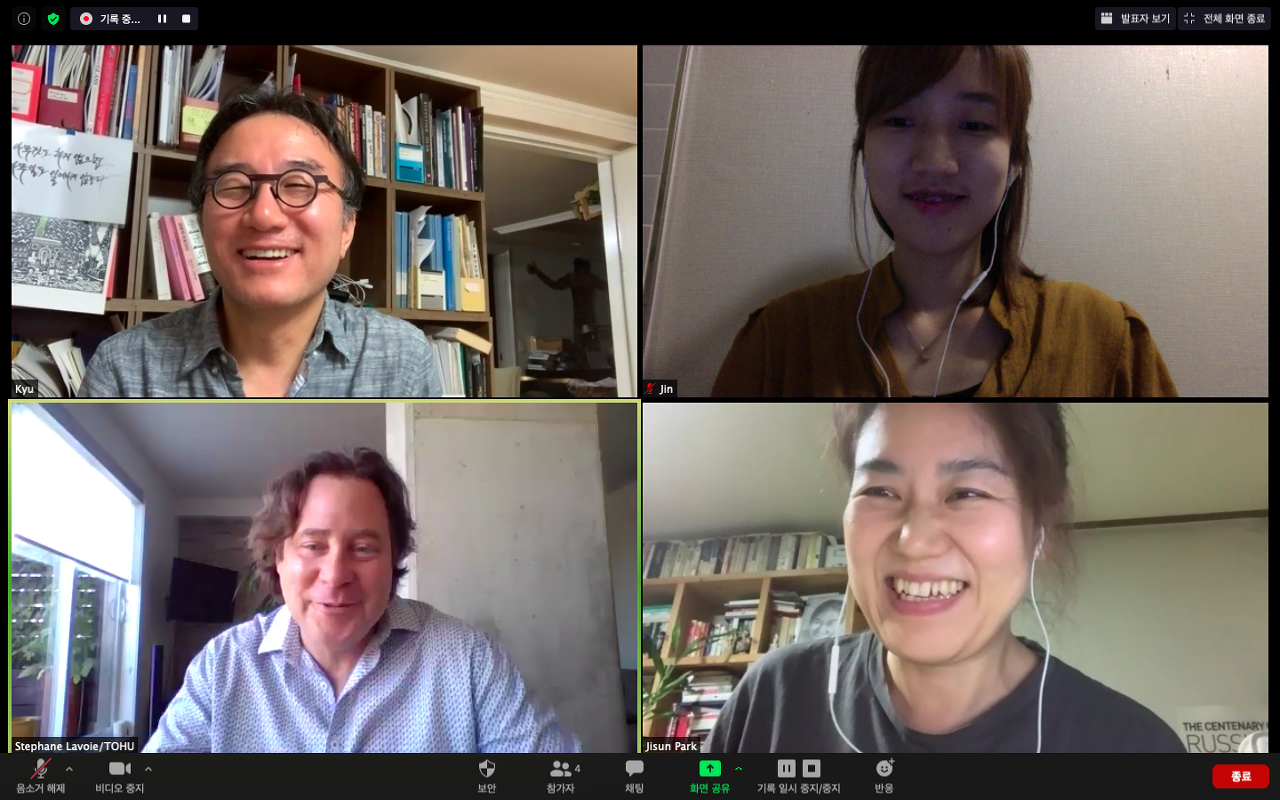
12th Online Conversation - La Tohu, circus creation theater in Montreal ⓒProducer Group DOT
Jisun: I had known the partners before but the interviews made me feel that they are more familiar, closer and more connected. That may be because we all share the same situation. We have worked together and engaged in tours and international exchanges but I have never thought that we were in the same situation. We have always had differences regarding our cultures, circumstances and financial systems. But this time, we all found ourselves in the same boat. So as each of us shared the current situation, we were on the same page and we could relate to each other even more. Under these circumstances, the conversations made me think of a new possiblity of solidarity.
Throughout the interviews, I was thinking about “art” and “practice.” The partners mentioned “green mobility” and “deep mobility” and they often talked about “carbon footprints” as well. This year, I“m running a new project called ”Climate Change Residency.” In this project, I discuss climate crisis, veganism and animal rights. Running a residency under this theme, I came to feel uncomfortable about eating steak. Unlike a TV series or movie, a residency consists in a long-term artistic activity. So I found it contradictory to separate such an activity and my own life. I had never brought my life so close to my artistic activity like this year. So I wondered to which point I should put it into practice. Contemporary art is not just about showing aesthetic values as it did in the past. Instead, art embraces contemporary discourses and issues, discusses them and approaches them with artistic methodologies in order to communicate with people. In this regard, I began to think about how art project planners and artists, who are engaging in such communication, could put all these things into their personal lives and take the issues with them.
Thinking about this results in many limits to what we can do. I finally came to a conclusion that there should be a clear reason for everything. For example, if we discuss green mobility and decide to stop air travel to minimize carbon footprints, this generates a limit to cross-border exchanges. So rather than deciding to block everything, I need to have a better understanding of the system, come up with my goals for international exchange and clarify reasons.
Why do I need international exchange? In the past, I had many reasons for this, like, because I love it, I enjoy it and I can have new experiences. But I now think that those reasons aren’t good enough. Going beyond personal experience and pleasure, I must have clear reasons. For example, I’m doing it because it is helpful for the arts ecosystem and it is valuable in a certain way. Of course, it would be difficult to work that way and it would also be tiring but it is necessary to find a direction in which art meets practice.
Kyu: One of the themes I absolutely relate to is “how to take action?” It is certain that I take action because I’m convinced of it but the point is how to put that idea into action.
Looking back, I stayed focused on questions about the aesthetic form of art in my 30s. That is why I chose the mime festival. I had questions about the artistic language of movements and images. Later on, I gradually put more emphasis on artistic aesthetics including aspects of places, spaces and sounds.
Since the mid-2000s, I have been very interested in the contemporariness of Asia, contemporary art and the modernization of tradition. Passing through my 40s, I’m now in my 50s and these questions have also changed for me. So currently, I ask questions about “contemporary contexts,” rather than stylistic and aesthetic nature of art, particularly during this pandemic period. In other words, I now think about stories I want to tell.
These days, it is all the more important for artists and planners to understand what to share with audiences and communities. In short, this is not actually about what art is but about what role art should play and what relationship art needs to have with society. The current challenging period seems to make such a relationship even more important. At times, when people discuss the relationship between art and society, they also talk from the perspective of activism and arts education. But these aren’t my major interests. So if I were to make something again as a planner, I believe that it is very important to clarify why I want to do it and what social context I want to talk about. In that sense, contemporary discourses that Jisun mentioned constitute an important issue.
Jin: Above all, what we need now is to take time to ask relevant questions again and again. If we don’t do that and just try to ignore what we are going through today, it may be more frustrating. What we have believed to be meaningful so far may not be so from now on. It is also necessary to understand that there could be a different way of doing something. Such a process could help us strengthen different muscles. It would be also meaningful to organize the questions we found during the conversations and to share them.
You had twelve interviews. For each of you, what was the keyword you related to most and what was the most impressive conversation?
Kyu: For me, the last talk is really memorable because Stéphane let me realize the reality as it is. The reality is that even after the pandemic ends, people and organizations wouldn’t change very easily. That interview made me ask this question. “What am I doing for transformation and transition?”
The interview with Anna and Giovanni from Italy’s Alto Fest is also memorable. If we are to change, what criteria do we need to adopt for the change? According to the two partners, festivals must have certain principles, in other words, basic philosophies. I thought about the importance of such principles again. That is, what we need to do is not about changing a form and thinking about an alternative. Instead, what is important is to have a certain philosophy or spirit and to use that as a basis to first ask “why.” In the case of this year’s Performing Arts Market in Seoul as well, what was important wasn’t just about moving to a digital online platform for the event. What we should have done first was to come up with our basic planning philosophy and strategies regarding the changing international exchange, mobility and digital online platform. And the interview with Pedro from Brazil let me realize again that those who cooperate find a new alternative if they have a common enemy or a clear common goal. Even if they have none of these, people do find an alternative because they become desperate.
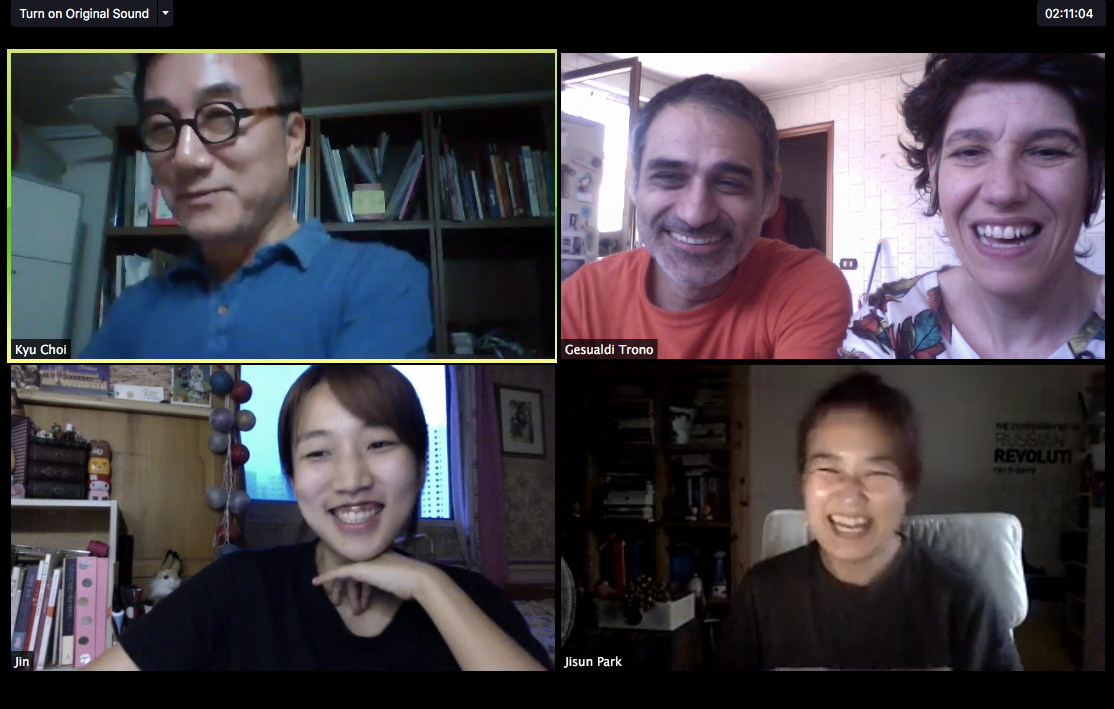
First Online Conversation – AltoFest in Naples, Italy ⓒProducer Group DOT
Jisun: The most impressive interviews are same as those mentioned by Kyu: the one with Giovanni and Anna, two directors of the Alto Fest and the one with Pedro from Brazil. Throughout the interview, Giovanni and Anna poured out so many ideas about what they are willing to do. For example, they suggested a way to organize the Alto Fest during the pandemic. This is how it works. First, they upload all the videos, books, photos and documents about the Alto Fest on their website. Second, they ask their space donors (citizens offering their spaces for artists during the festival) to invite their family and acquaintances to their places. Third, they encourage them to look at such films, videos and documents about the Alto Fest at home and discuss them. I believe that it is a really great idea. What the directors are trying to do is in line with the spirit of the Alto Fest and if such a program takes place in 30 houses, that is a festival. What is the most important for the Alto Fest is to ensure that the community stays with the arts in the city. Such reflection on the style is linked to the festival’s spirit. We need to invite international artists but we can’t. Artists need to perform but they can’t meet the audience. In such a case, we just think that we can’t organize the festival. But they have designated the community as the main actor. In accordance with what the Alto Fest pursues, they want people to pollute the city with art. This led me to believe that if I’m clear about why my festival should exist and what I’m trying to do, I could expand creative ideas in different ways. This year in Korea, many festivals had to be canceled, moved to an online space or reduced in size. I wonder how much we have reflected on very fundamental questions like why our festivals should exist in this era and why and how they should meet people in the city. In this regard, the interview with them was impressive and they made me ask many questions.
The conversation with Pedro from Brazil was very different from all the other talks. In European countries like the UK, Germany and Belgium and in Montreal, Canada, it is true that everyone is going through a challenging period but those countries continue to support artists’ livelihood and creation. In contrast, Brazil has a chaotic political scene and the country doesn’t provide any support for artists. Among the situations faced by the partners we talked to, Brazil’s situation was the worst. Nevertheless, Pedro talked more enthusiastically than any other participant and he demonstrated solidarity and cooperation with artists under artistic themes. As everyone is facing challenges amid the pandemic, it is definitely necessary to think about how to support the livelihood of those in the arts scene. In this context, the talk with Pedro stimulated and inspired me to think about what voices artists should have during such a period.
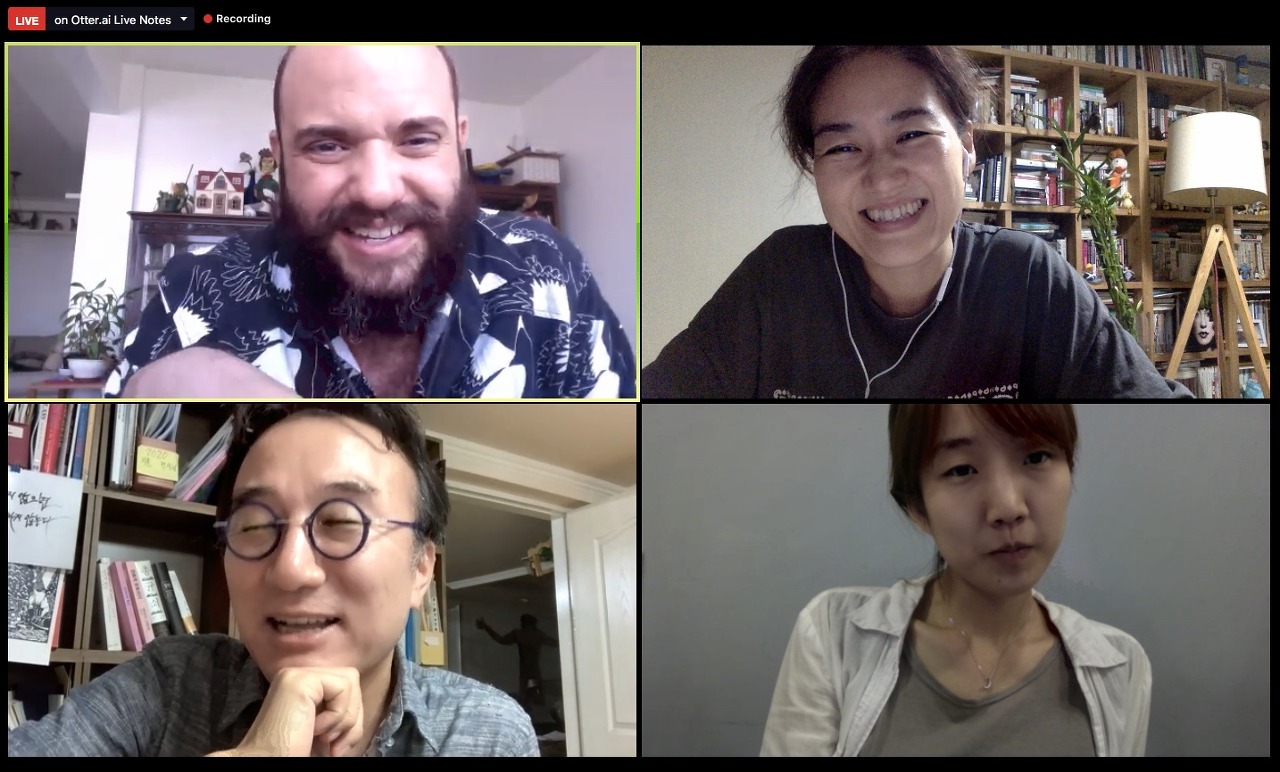
11th Online Conversation – FAroFFA (online solidarity market in Brazil) ⓒProducer Group DOT
Kyu: Crisis and danger inevitably occur anytime, in any form. For a platform, having its own philosophy and goal provides a sustainable driving force so that it can overcome any crisis. If there is no such thing, crisis makes us close the door. So it is important to keep thinking about where I’m headed and what my philosophy is. That is essential to turning a crisis into a productive occasion.
Jin: If we can’t change or if we are unwilling to change, a crisis becomes a real crisis. When we think together that a change may be necessary, that we can change and that the change could be fun, and when we start moving forward together, meaningful things happen. Art would have changed in this way. I definitely agree that a crisis serves as an occasion for change. For this, we need solidarity. Put differently, we can’t do it alone. Personally, the most interesting talk was the one with Ian Leung at Hong Kong Arts Centre. Ian is a warmhearted and enthusiastic person but he is also cool-headed. His message is that from now on, meaningless art will be visible. He means that we should ask ourselves if art is really suggesting social solutions and if it is playing a role of reflecting our contemporary era as it is. He says that if we don’t find such a meaning, art may fall behind. In other words, does today’s humanity need the arts we have now? If such arts are unnecessary, it will inevitably fall behind.
Jisun: I agree. As Ian said, there are certainly artworks that are meaningless, that will inevitably fall behind and that will stay just inside museums. This is also linked to “art” and “practice” I mentioned earlier and I don’t want to trap art in the language of “social art.” The reason why an artist should exist in this world may be different from that of the past. Artists aren’t activists or those leading political movements but art is not there to give people just joy and beauty. In the past, there would have been a period in which art existed to offer just joy and beauty. But today’s world brims with joy, pleasure and all kinds of entertainment. In this context, we need to think about how those in the arts scene and art itself could lead people to look at today’s lives differently. Today’s society is very uniform. Everything is dominated and uniformized by the media. This is very contradictory because diversity and uniformity coexist. People put on similar clothes, meet at similar coffee shops, watch the same TV shows and enjoy the same content produced by Netflix. They seem to be headed to one direction. I believe that art is about changing all of this. In anything that remains uniform, art should keep generating cracks and paths. In this way, people, who have moved uniformly, would find a new way at some point and take a different direction. That is what Giovanni and Anna are doing because they are also generating cracks. But if art doesn’t play such a role today, it will end up being absorbed into entertainment or into museums. Therefore, art’s ultimate goal is to remind us of what is necessary for a given era, by means of these values. In that sense, I agree with Ian.
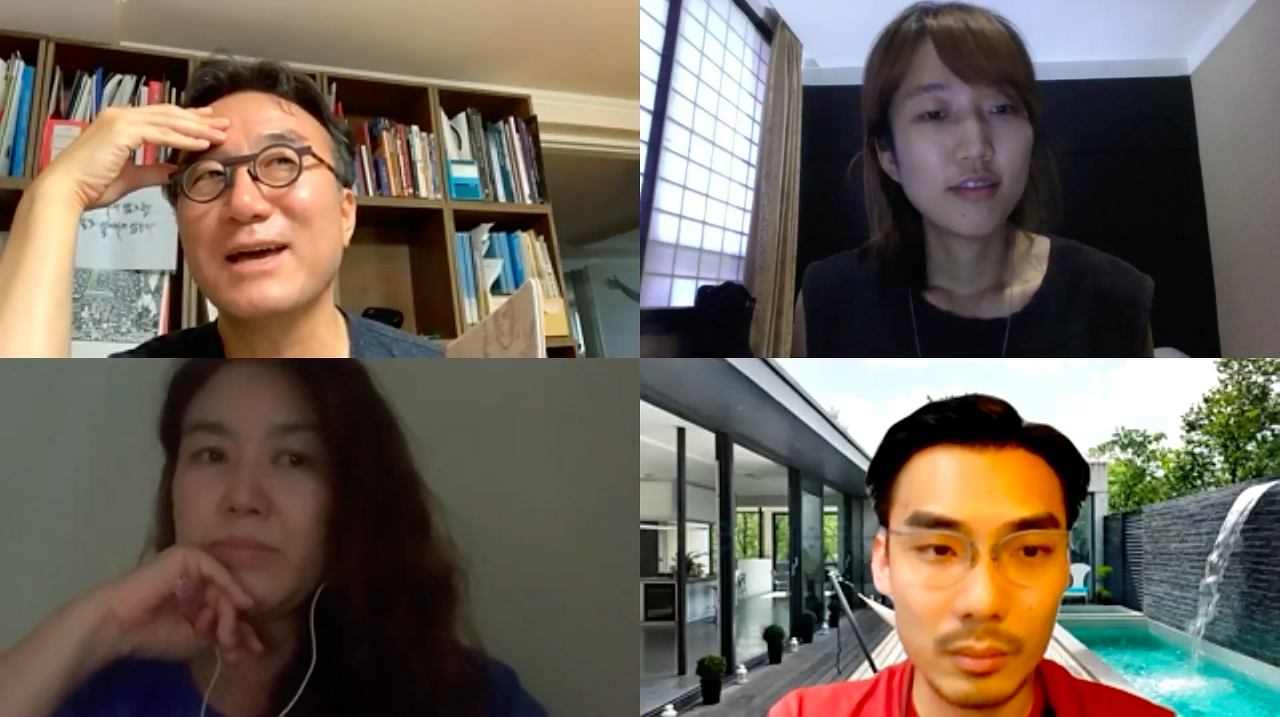
10th Online Conversation - Hong Kong Arts Centre ⓒProducer Group DOT
Jin: There is another memorable thing Ian mentioned. According to him, the existing hierarchies of the arts scene are collapsing. Such hierarchies had been destined to collapse at some point and now, we can say that we are seeing the end of them. A hierarchy that determines “good art”, the one that specifies the methods and forms of art and the one that decides what art to show have all collapsed, thus becoming meaningless. Instead, we realize that we have ushered in an era in which good works come from those who think faster and more seriously, right on the spot. It is rare to see such a great number of things unveiled in a short period of time. But it is what happened in 2020.
Jisun: Many hierarchies are already collapsing. As I said earlier, we are experiencing an unprecedented situation together. Nobody has experienced this before. Nobody can be convinced of a new method or clearly predict the future of the performing arts. In fact, even if we try to deny this, hierarchies of the arts and culture have certainly existed. After the collapse of such hierarchies, new ones will be made in no time. If someone moves fast, they will be rebuilt.
Other impressive elements are solidarity and cooperation. Europe has formed solidarity mostly in EU and it has moved fast to overcome and solve problems. Serge, director of the Théâtre de Liège in Belgium, says that EU emphasizes the mobility of the arts more than before. He explains why. Europe and the world currently show strong tendencies of turning rightist and becoming nationalistic. Under these circumstances, closing the borders would further expand such tendencies. For them, art and artists need to move around for a great variety of reasons, from personal ones to political ones. Today, everyone lives in the same present. Nevertheless, when it comes to understanding the situation and sharing resources, they are obviously working faster and more structurally than Koreans do, thanks to their existing network and basis.
Kyu: I attended the European Theatre Forum, which was organized by the European Theatre Convention, for three days. Under its economic/political community, EU has an arts and culture community structure. So when programming such a forum, not only artists, planners and arts professionals but also funding institutions and arts policymakers participated in the forum in order to come up with a policy suggestion composed of eight future courses of action.
We say that Asia needs solidarity. But we don’t say it together. In order to prevent our solidarity from ringing hollow, we need to go beyond artists’ discourses. What is solidarity with policies and politicians? What is Asia’s arts community and is it necessary? And what do we need to do in such Asian solidarity? These are questions that came to my mind. If that is impossible in reality, do we need to form new solidarity within small individual units based on the current state of Asia? In some way, I felt envious of the structure of EU’s arts community. But Asia should find its own way.
To be continued in part 2 [LINK]








 PREV
PREV
.jpg)
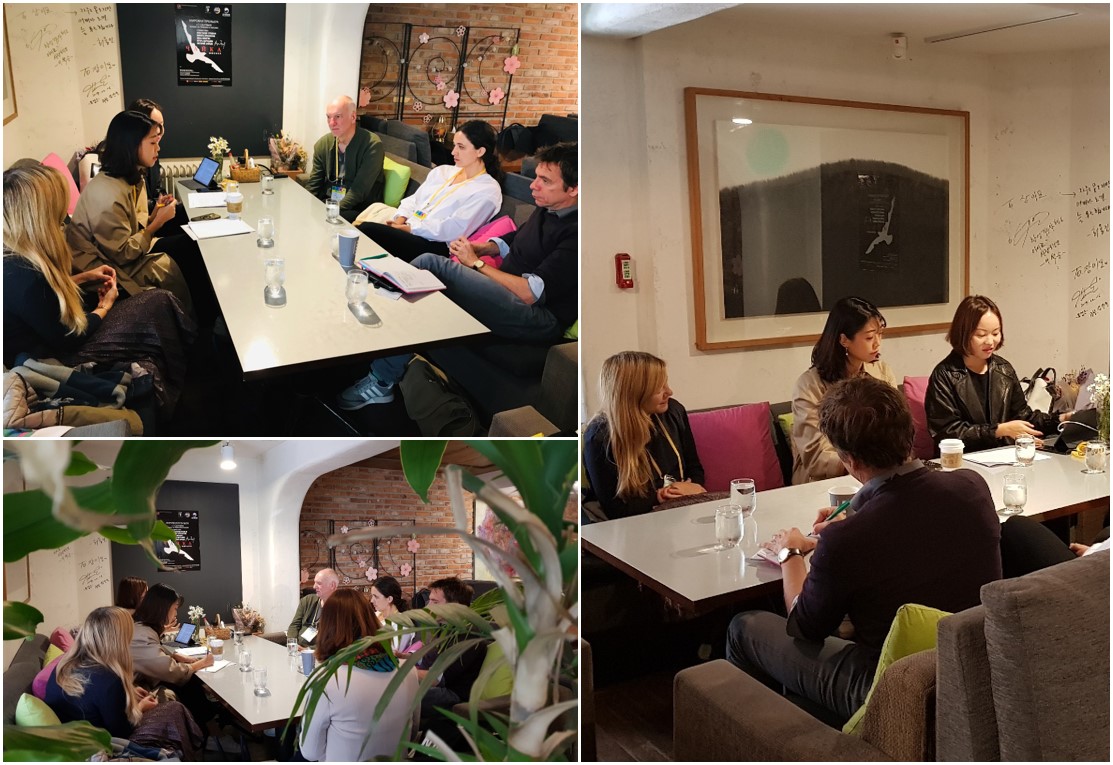
.jpg)
.jpg)
.jpg)
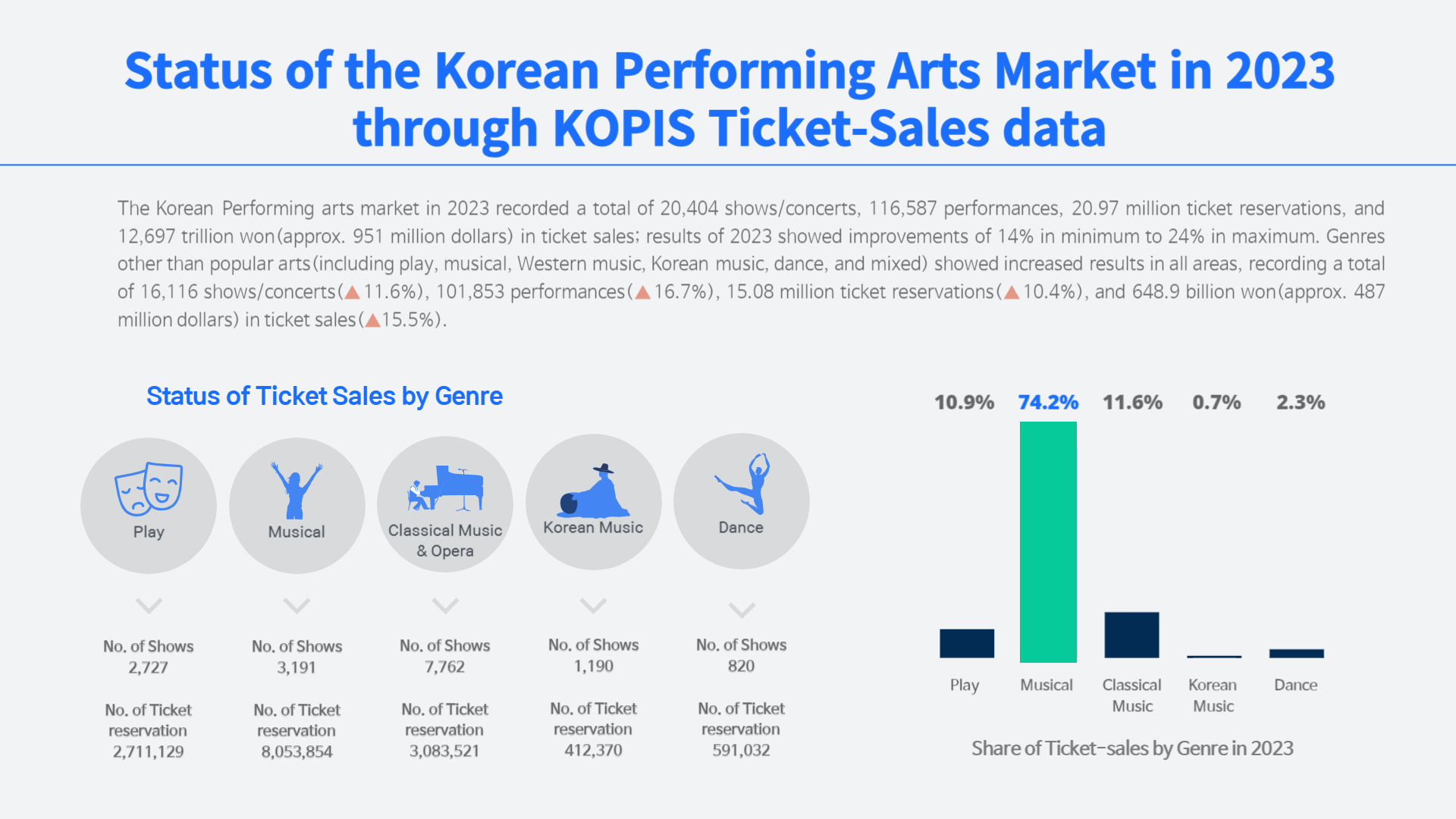
.jpg)
.jpg)
.jpg)
.jpg)











